A MOVEABLE FEAST
From maple syrup to pecan pies – An ABC of American food, Part 2
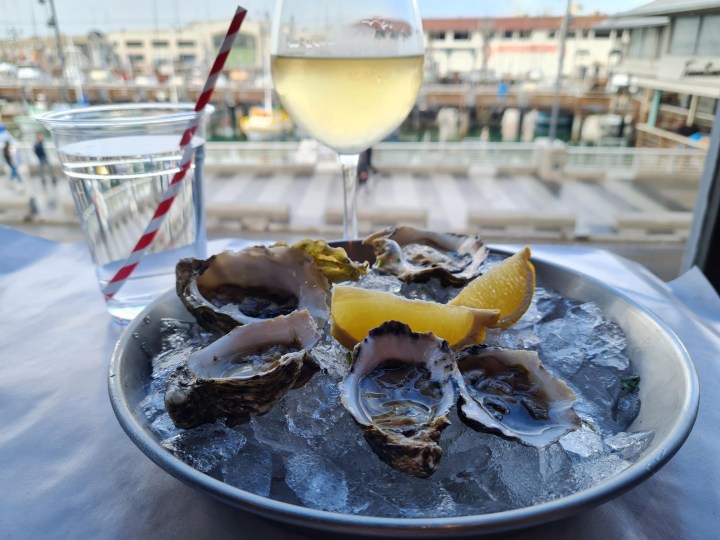
We are still tasting our way through America, across the continent, state by state, plate by plate.

State Park on the Big Sur coast where we toasted marshmallows. (Photo: Marita van der Vyver)
M is for maple syrup and marshmallows toasted over an open fire. This is how far I got last month with my culinary ABC, before we had to return our rented camper van in San Francisco and fly back to the East Coast where our road trip had begun in November.
Now we are spending a rather more sedentary month in a house in North Carolina, exploring Georgia and the Carolinas, happy to have a kitchen again. The food journey continues, though, as we remember the weird and wonderful dishes we discovered – and try to recreate some of these tastes in our borrowed kitchen.
Our foodie ABC also continues, from M to Z, with maple syrup which originated in New England and has become as quintessentially American as apple pie. Although apples aren’t really American, as we should know from Greek and Roman mythology and ancient European fairy tales like Snow White with a heroine who bites into a poisoned apple.
Marshmallows toasted on a campfire, on the other hand, are a true American treat. Although the sweet was created, perhaps not surprisingly, by French patissiers in the 1800s, the modern-day marshmallow was perfected by American manufacturers and popularised by the Girl Scouts who published a recipe for toasted marshmallows eaten with chocolate on crackers in their 1927 Handbook.
An American friend introduced me to this over the top snack many moons ago, but I still prefer the simpler version of my childhood, skewered on a stick and held over an open flame until the outer layer turns a little crackly, beautifully bronzed rather than burnt black, and you can slurp the melting interior straight off the stick. As we camped in a few almost deserted state parks during our road trip in the middle of winter, we had more than one occasion to light a small fire and ignite childhood memories.
The toasted marshmallows we enjoyed one full-moon night on the wild Big Sur coast of California, with no other human beings in sight, the crashing waves of the Pacific as background music and the odour of enormous eucalyptus trees all around us, proved to me that it was indeed never too late to have a happy childhood.

New Mexico chillies. (Photo: Marita van der Vyver)
N is for New Mexico chillies and New Orleans po’boys. We loved the area around Santa Fe, the simplicity of the adobe buildings rescued from boredom by daring combinations of colours, bright turquoise and shocking pink and burnt red. We also loved the New Mexico food, the spicy burritos and tortillas, and my partner who adores chili peppers couldn’t stop smiling – or eating. Santa Fe’s cultivar, first grown by Spanish and Pueblo communities in the area, is apparently the closest you can come to the famously fiery guajillo pepper if you’re not quite brave enough for the real McCoy. (Mea culpa – but my partner made up for my cowardice.)
New Orleans is another city we loved as much for its looks and its vibe as for its food – and the traditional NOLA snack that any traveller should taste at least once is the po’boy. The most famous place to try this is still Parkway Bakery, far away from the tourist crush of the French Quarter, where poorboys or po’boys have been served for more than a hundred years. As the name suggests, this sandwich filled with fried seafood or meat started out as food for those whose hunger was bigger than their budget, so one can’t expect a gourmet meal. Still, I was underwhelmed.
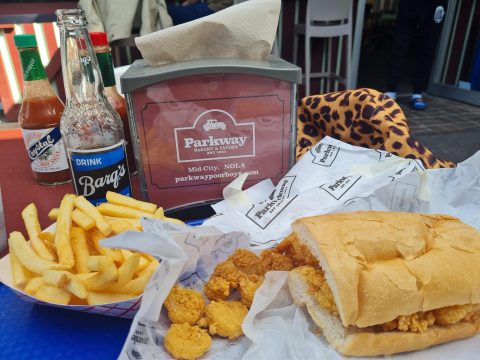
New Orleans’ famous po’boys. (Photo: Marita van der Vyver)
We tasted Parkway’s po’boys with shrimps and other seafood, and gave it another try at the French Market, this time with meat. Once again Alain was braver than me and ordered his with alligator meat. I settled for plain beef. And the verdict was the same: This is one New Orleans tradition I won’t be raving about.
Both times the so-called French bread was too soft on the inside, the crust too tough and chewy, the filling too greasy. But because I know that food taste is an intensely personal thing, I won’t discourage anyone from trying a po’boy when visiting New Orleans.
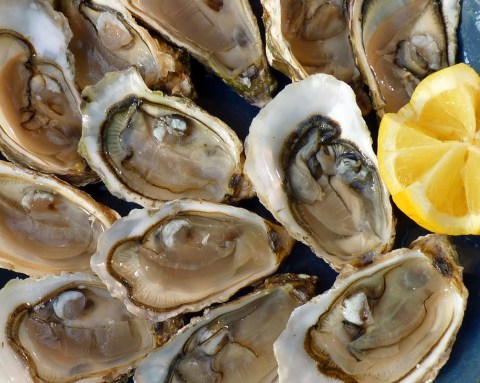
(Photo: macayran on Pixabay)
O is for oysters and organic food. Both categories are big on the East and the West coast, from New England to California, but not so much in the interior of this huge country. At least not in the supermarkets and gas station stores we visited along Route 66 and other interstate roads. By the time we reached the Fisherman’s Wharf in San Francisco, I was really craving one little oyster.
But I wasn’t allowed to order a single raw oyster, as I often do at markets in France, and since Alain prefers his oysters cooked, I had to slurp up half a dozen on my own. I could slurp up three dozen, if only our budget allowed it, so I’m really not complaining.
And by the time we reached urban California, after all those bagels and donuts and biscuits and endless fried food, I was in dire need of fresh vegetables. Our friend Robin cooked us a restorative meal of salmon and crisp green asparagus in her Santa Barbara home, and took us to an organic farmers’ market early on a Saturday morning. What a pleasure to see all those pretty displays of colourful vegetables – skinny rainbow carrots, blush-pink and pale green salads, deep-purple kohlrabi, green peppers glowing like my ouma’s polished stoep – and various shades of heirloom eggs arranged like paints on a palette.
This was also America, we realised, always surprising us with its culinary and cultural contradictions, its neverending variety, its constant refusal to fit into any preconceived box.

‘Pecáhn pie’ from Texas. (Photo: Marita van der Vyver)
P is for pecan pies, even more American than apple pies because pecans are really indigenous. Archaeological evidence in Texas indicates that Native Americans already used these nuts more than 8,000 years ago. In fact, the word pecan is derived from an Algonquin word, pakani, referring to several kinds of nuts. Which is probably why Americans pronounce it differently – pecáhn rather than péécan, as we learned from a snotty waitress in a Texas diner.
After repeating our request three times without being understood, we finally pointed to the item on the menu. “Ah, you mean pecáhn,” the waitress said in that superior tone I’d thought only Parisian waiters could get away with. (I have to add this was the only time an American waitress ever treated us with anything less than astonishing chirpiness.)
Q is for quahogs, the speciality clam of New England, which we hope to taste when we return to the north-east of the country before flying back to Europe. Meanwhile we’re still expanding our experience of all sorts of clam chowder, even planning a home-cooked version in our temporary North Carolina kitchen.
R is for refried beans and red beans with rice. The first dish is a fabulous staple of Mexican and Tex-Mex meals that we tasted homemade in a friend’s Californian kitchen, the other one an emblematic taste of Louisiana Creole cuisine traditionally cooked on Mondays with leftovers from Sunday’s dinner. We will attempt to cook both while we are still in the USA.

Saltwater taffee in Santa Cruz. (Photo: Marita van der Vyver)
S is for salt water taffee and salted caramel. I suppose I could also say S is for sugar, but sugar is so omnipresent in this country that I don’t need to remind anyone of it, so I prefer to praise candy with a more unusual salty taste. Of course salted caramel is not really American; like marshmallows it was created in France, but like marshmallows it was popularised for the masses in America, and can now be bought even in supermarket chains like Walmart.
If you want a fancier version, you have to pay for it, though. As I realised when I bought a small square of outrageously expensive salted caramel fudge in a fancy candy store in Carmel-by-the-Sea. Actually everything in this town seemed expensive to me, even the air tasted expensive, as could probably be expected of a place where a major Hollywood star had been chosen as mayor. It is more than 30 years since Clint Eastwood’s term, but Carmel still exudes a certain glamour.
Or so I tried to convince myself as I slowly swallowed the most expensive piece of fudge of my entire life while watching a cinematic sunset on Carmel’s glamorous beach.
Salt water taffee is a kind of soft toffee originally produced in Atlantic City, New Jersey, and no, it is not made with seawater as I thought. When we wandered along Atlantic City’s famed boardwalk one icy night we needed stronger sustenance than sweets, so we didn’t buy the colourful candy there. But we did try it on the opposite side of the continent, in Santa Cruz on the Californian coast. Maybe my teeth are getting too blunt for taffee, but I definitely prefer salted caramel fudge.

Memphis, where I had my first plate of fried green tomatoes. (Photo: Marita van der Vyver)
T is for tomatoes, specifically fried green tomatoes, which I couldn’t fit in under F for Fried or G for Green, but had to mention somewhere in this culinary alphabet. Like the pizza I first encountered in an Archie comic book in the seventies, fried green tomatoes was something else I discovered through American popular culture many years before I actually tasted it. Fried Green Tomatoes was a 1991 movie with Kathy Bates and the dearly missed Jessica Tandy and Cecily Tyson, and ever since I watched it I’ve been yearning for this Southern dish.
I finally ate my first plate of fried green tomatoes in a blues bar in Memphis. (You can’t eat without live music in Memphis.) As so often in America I wished the portion was a lot smaller, and in this case I also wished the breadcrumbs coating was just a little thinner so I could taste more of the slightly sour tomato and less of the deep-fried crumbs.
But hey, I don’t expect a beloved traditional dish to be changed to suit my personal taste. So this is probably another American favourite I’ll be adjusting to my own taste in my own kitchen someday when I have my own kitchen again.
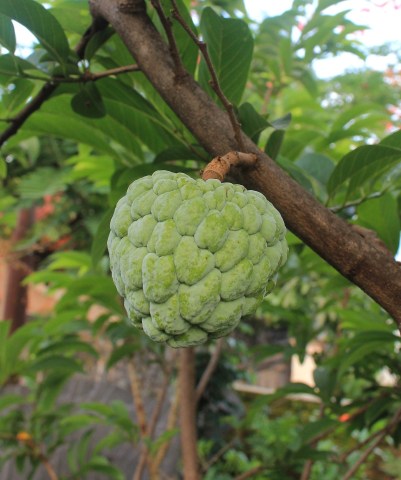
Cherimoya. (Photo: mayapujiati on Pixabay)
U is for unusual Californian fruits, like finger lime, white sapote and especially cherimoya, which we managed to buy at that organic market in Santa Barbara. Not without trepidation, because it is a strange heart-shaped object with a green armadillo-like skin and we had no idea how to eat it. A friend advised us to cut it open and scoop out the soft white flesh with a spoon, taking care to spit out the many shiny black pips.
“But what does it taste like?” we kept asking – and no one could give us an exact answer.
“A mixture of pineapple and peach and pawpaw and banana,” was the closest clue we got.
We left it for a couple of days in our camper van, and the longer we waited the more convinced we became that it would inevitably be a disappointment. So what a lovely surprise it was when we finally cut open the fruit one day while watching the gigantic elephant seals congregating on the beaches of San Simeon. I’m sure it would have tasted good even without the seals.
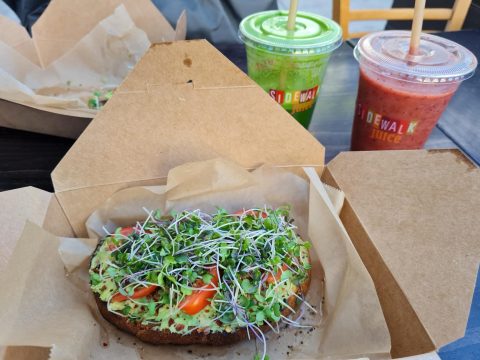
A healthy vegan breakfast in trendy San Francisco. (Photo: Marita van der Vyver)
V is for vegan and vegetarian food, still more widely available in American cities than in France. I’m not considering veganism, but I was grateful to have a couple of vegan meals in the ever hip San Francisco at the end of a road trip through some southern states where it was hard to find vegetables not fried or overcooked even with meat or fish. Requesting raw vegetables without meat or eggs or cream or cheese at roadside eateries seemed a lost cause from the start.
So three cheers for the avocado and tomato toast we enjoyed for breakfast in the colourful neighbourhood of Haight-Ashbury, with green vegetable juice and a red berry smoothie instead of the usual weak coffee we’d been forced to drink for weeks.
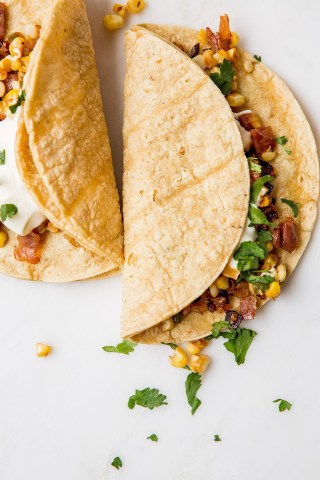
(Photo: samuelfernandezrivera on Pixabay)
W is for wraps, the generic term for Latino burritos or tortillas and Vietnamese salad rolls and Asian rice paper rolls and all the sandwich versions created in America. We usually bought “old-fashioned” sandwiches (when we couldn’t make our own with fresh bread) rather than wraps, but we did have a few delectable wraps on Christmas Eve when we treated ourselves to a three-course meal in a stylish Vietnamese restaurant. Which brings us to X for Xmas food.
X is for Xmas food, as varied as the many different cultures forming the Americans who celebrate Christmas. Although the traditional holiday meal often still resembles a Thanksgiving dinner with turkey, stuffing, gravy, cranberry sauce etcetera, a Louisiana Christmas meal would definitely differ from a New England or a New Mexico or a Californian version.
Since we spent Christmas Eve in a guest house on Nob Hill in San Francisco, strangers in a city where we knew nobody, we had to eat out or starve. And since many restaurants were understandably closed on this night when families want to be together, we decided our safest bet would be an Asian place, enjoying the cuisine of an ethnic group who didn’t necessarily celebrate Christmas – which is how we landed in a lovely Vietnamese restaurant with French colonial decor.

Xmas Eve in a Vietnamese restaurant in San Francisco. (Photo: Marita van der Vyver)
Only later, while doing research for this column, I realised that we’d unconsciously honoured an old American Jewish tradition of eating Asian food (usually Chinese) on Christmas. This started over a century ago in New York because Chinese cooking was virtually dairy-free and thus more likely to be kosher than most other cultures’ food in which meat and dairy products were mixed. And, of course, Chinese restaurants were often the only ones open on Christmas Eve or Christmas Day.

Blueberry muffin. (Photo: btfrewinphotography on Pixabay)
Y is for Yankee food, and for “Yay! I managed to find an entry for Y!” And Yankee food brings us back to Xmas food, once again, because most of the traditional American Christmas and Thanksgiving meals originated in the Yankee country of New England. Yankee food also includes other eternal American favourites like blueberry muffins and pumpkin pies and various combinations of fresh seafood, most of which we’ve tasted by now or intend to taste before we fly back to France.
Z is for Zydeco food. Zydeco is a kind of black American dance music, typically featuring accordion and guitar, originally from southern Louisiana. And, believe it or not, you get Cajun-Creole food that goes with this music, and there are numerous restaurants and food trucks claiming Zydeco as their official name.
Now we have reached the end of the alphabet, although not the end of our culinary journey. After all, it is the journey that matters, not the destination, and we still don’t know what our final destination will be. DM/TGIFood





 Become an Insider
Become an Insider
Lovely/lekker observant journey. Er, maple syrup is also very Canadian.